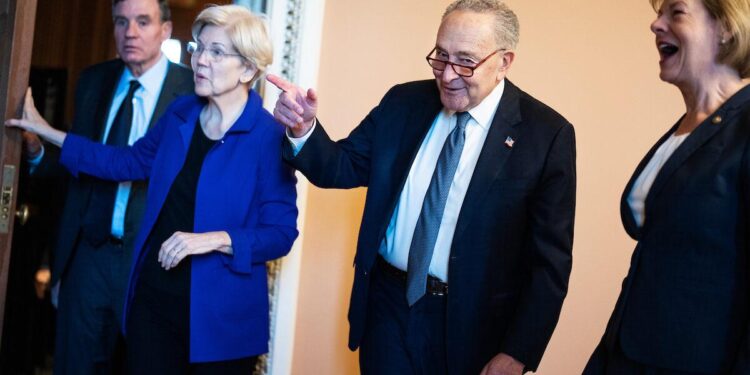A leading Senate Democrat has sharply criticized the state of the U.S. economy under former President Donald Trump, describing it as marked by “uncertainty” and “chaos.” Speaking amid ongoing political debates over economic policy, the lawmaker highlighted concerns about instability and unpredictability tied to Trump-era decisions. This latest critique adds to the growing partisan discourse surrounding the country’s financial direction and the lasting impact of the previous administration’s economic approach.
Senate Democrat Questions Stability of Trump Economic Policies Amid Market Volatility
Senate Democrats have voiced deep concerns over the unpredictability of economic policies implemented during the Trump administration, highlighting a mounting unease amid recent market fluctuations. Critics argue that rapid shifts in trade tariffs, inconsistent regulatory approaches, and erratic fiscal strategies have contributed to an atmosphere of economic uncertainty that risks destabilizing investor confidence. “The constant back-and-forth leaves businesses and consumers scrambling without a clear path forward,” one lawmaker noted, pointing to the recent volatility in key stock indices as evidence of the fragile market environment.
To illustrate the impact, experts have linked several market indicators to policy changes, underscoring a pattern of volatility around significant political announcements. The table below summarizes selected economic metrics alongside corresponding Trump-era policy events, reflecting a trend that fuels apprehension among Senate Democrats about sustained economic growth:
| Policy Event | Market Reaction | Economic Indicator |
|---|---|---|
| Tariff announcements on China | Sharp index drops | Manufacturing PMI ↓ 5% |
| Tax reform enactment | Initial rally then decline | Corporate debt ↑ 8% |
| Withdrawal from trade agreements | Increased volatility | Export orders ↓ 3% |
- Critics warn: Lack of long-term strategy amplifies risk.
- Supporters claim: Policies stimulate short-term growth despite risks.
- Market watchers observe: Investors remain cautious amid policy reversals.
Analyzing the Impact of Uncertainty and Chaos on Business Confidence and Consumer Spending
Businesses across various sectors have reported a notable decline in confidence, largely attributed to the prevailing atmosphere of uncertainty and perceived chaos. Market volatility, unpredictable policy changes, and inconsistent regulatory signals have left executives hesitant to commit to large-scale investments or expansions. This hesitancy cascades down to consumer behavior, with many households tightening discretionary spending as fears of economic instability grow. The resulting slowdown in consumer demand exerts additional pressure on businesses that rely heavily on steady revenue streams, creating a feedback loop of caution and contraction within the economy.
The interplay between uncertainty and consumer confidence becomes clear when examining recent economic indicators. According to an internal survey of leading corporations, the majority identified policy unpredictability and supply chain disruptions as primary factors dampening their outlook. Meanwhile, consumer expenditure on non-essential goods has dipped, signaling greater financial prudence amid unclear economic prospects. The table below summarizes some key metrics reflecting this trend:
| Indicator | Current Status | Change (3 months) |
|---|---|---|
| Business Confidence Index | 42 (out of 100) | ↓ 15% |
| Consumer Spending on Discretionary Goods | $350B | ↓ 7% |
| Supply Chain Reliability Score | 58% | ↓ 10% |
- Market unpredictability has led to cautious investment strategies.
- Consumer risk aversion increases as economic signals become mixed.
- Supply disruptions contribute significantly to reduced business output.
Calls for Transparent Economic Planning and Bipartisan Solutions to Restore Market Trust
In response to the prevailing economic uncertainty, several Senate Democrats have issued urgent appeals for a comprehensive overhaul of the nation’s fiscal strategy. They emphasize that clear, data-driven plans are essential to reversing the prevailing market instability and restoring confidence among investors and consumers alike. By advocating for transparent policy frameworks and openly communicated goals, lawmakers aim to demystify economic decision-making processes that have increasingly appeared erratic over the past years.
Central to these calls is the push for bipartisan cooperation, as partisanship has contributed significantly to the current volatility. Key proposals include:
- Regular economic reporting that provides real-time updates on market health and governmental actions
- Joint congressional committees tasked with evaluating economic legislation before enactment
- Cross-party task forces dedicated to stabilizing financial markets during crises
| Action Item | Expected Outcome |
|---|---|
| Transparent Budget Proposals | Improved investor confidence |
| Bipartisan Economic Panels | Balanced policy measures |
| Enhanced Market Monitoring | Reduced volatility |
In Conclusion
As the debate over the state of the economy continues, Senate Democrats remain critical of the current administration’s approach, labeling it fraught with “uncertainty” and “chaos.” With economic indicators and policy decisions under close scrutiny, both parties are poised to use the evolving financial landscape as a focal point in upcoming political battles. The coming months will be crucial in determining how these critiques translate into tangible impacts on the nation’s economic direction and voter sentiment.
















![[News] Japan Develops 10nm Nanoimprint Technology, with Potential to Tackle EUV Bottleneck – TrendForce](https://earth-news.info/wp-content/uploads/2025/12/329851-news-japan-develops-10nm-nanoimprint-technology-with-potential-to-tackle-euv-bottleneck-trendforce-360x180.jpg)














